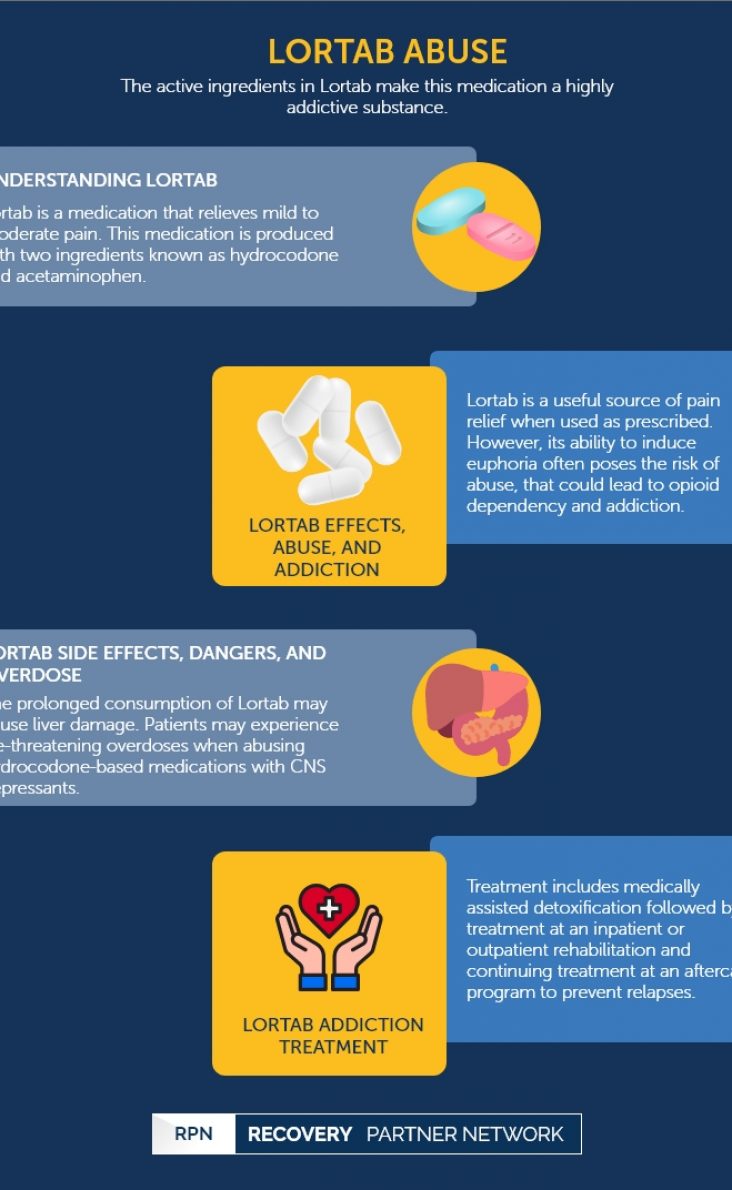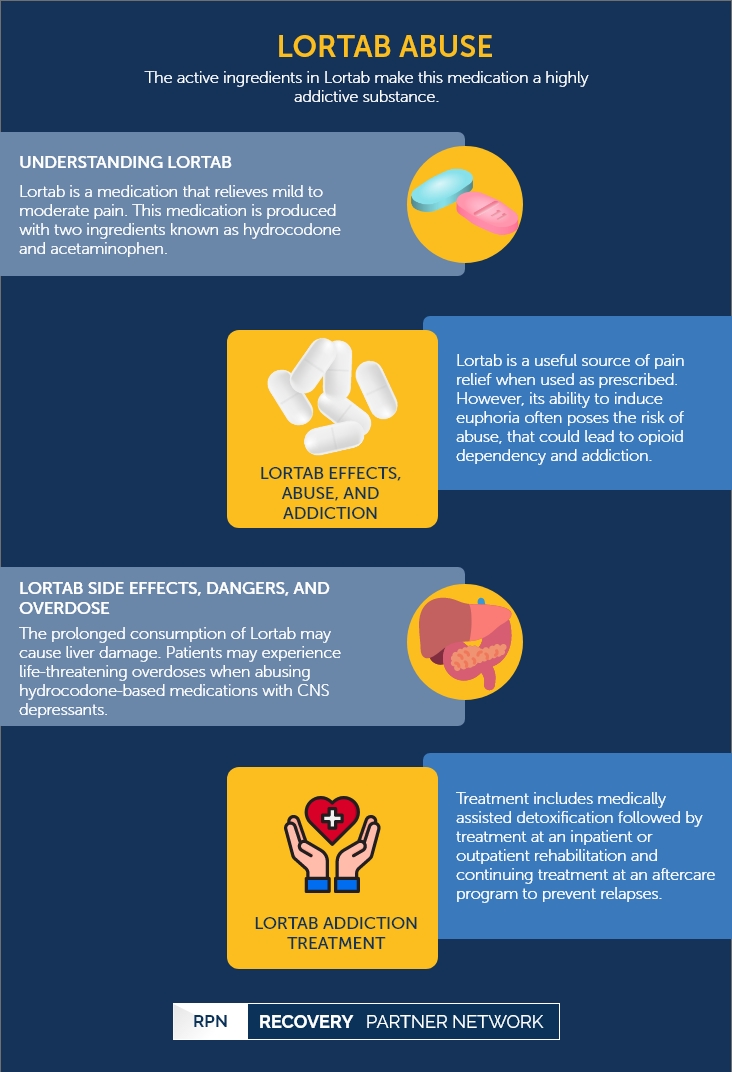The active ingredients in Lortab make this medication a highly addictive substance.
Lortab Abuse
Opioid
- Hydrocodone/paracetamol addiction
- Buprenorphine/Naloxone addiction
- Central nervous system depressant
- Codeine addiction
- Dextropropoxyphene addiction
- Fentanyl abuse
- Hydromorphone addiction
- How Long do Opioids Stay in Your System?
- Hydrocodone addiction
- Kava addiction and abuse
- Loperamide addiction
- Lortab addiction
- Medical prescription opioid
- Methadone addiction
- Morphine addiction
- Norco addiction
- NyQuil addiction
- Opioid use disorder
- OTC substance abuse
- Oxycodone addiction
- Oxycodone/paracetamol addiction
- Opioid epidemic
- Lean addiction
- Pethidine addiction
- Snorting Oxycodone
- Synthetic Opioids
- Tramadol addiction
Lortab addiction | Table of Contents
Understanding Lortab
Lortab is a medication that relieves mild to moderate pain. This medication is produced with two ingredients known as hydrocodone and acetaminophen. Acetaminophen, also known by its brand name Tylenol, is a prescription medication used in relieving mild pain and fever. Hydrocodone, the most active ingredient in Lortab, is often used for pain management, but unlike acetaminophen, hydrocodone is an opioid that causes overdose and addiction. Acetaminophen in Lortab improves the pain-relieving effects of hydrocodone. The formulation of Lortab is similar to that of Vicodin, another hydrocodone pain reliever.
FAQ
The length of time Lortab stays in an individual’s system depends on many variables, including age, metabolism, fluid intake, liver and kidney function, dosage, and other medication consumed. The acetaminophen in Lortab has a half-life of 1.15 to 3 hrs in the blood. Hydrocodone has a half-life of about 4 hours. It is detectable in urine tests for up to three days, depending on other factors. It can be detected in a hair test for up to 90 days.
You can take Lortab as often as 1 to 2 tablets every 4 to 6 hours as required. Your doctor may increase the dose when necessary, but the dose should usually be no more than 12 tablets per day.
Lortab Effects, Abuse, and Addiction
Lortab functions in a similar manner to most other opioid-based medications. When an individual consumes a Lortab pill, it attaches to the opioid receptors in the brain and nervous system. This triggers the production of dopamine and other neurotransmitters that dull pain sensation and cause euphoria. Lortab is an effective source of pain relief when used as prescribed. However, its ability to induce euphoria often poses the risk of abuse. Lortab is regulated as a schedule III drug under the drug classifications in the US and is considered unlawful to use or obtain it without a prescription.
When an individual consumes Lortab beyond the guidelines of a prescription, they may run the risk of developing dependence and tolerance to the drug. Once this occurs, the individual may consume higher doses of Lortab to achieve the initial sedated and euphoric effects of the drug. Individuals who form a tolerance to Lortab’s effects are also more likely to experiment with other opioids, which may inevitably lead to opioid dependency and addiction. An individual addicted to Lortab or other forms of opioids will continue their drug use despite serious physical and psychological consequences.
Although Lortab is not notorious for being addictive, addiction does occur. About 5 percent of patients who receive a prescription for Lortab or other opioid-based medicines will eventually abuse the medication and risk the development of an addiction. However, an addiction to Lortab is avoidable if the medication is only used as prescribed.
Lortab Withdrawal
Opioid withdrawal can be a traumatic experience. Patients may experience a withdrawal when they abruptly cease their consumption of Lortab or lowers their dosage. Withdrawal often prevents patients from recovering from opioid addiction.
Symptoms of Lortab withdrawal may include:
- Anxiety
- Chills
- Stomach problems
- Sweating
- Tearing of the eyes
- Heightened blood pressure
- Increased sensitivity to pain
- Congestion
- Frequent yawning
- Insomnia and restlessness
- Irritability
- Muscle aches
- Nausea and vomiting
- Rapid heartbeat
- Runny nose
- Shaking and tremors
While the effects of withdrawal are unpleasant and distressing, the symptoms typically start to improve within 72 hours and subside within a week.
Lortab Side Effects, Dangers, and Overdose
Side effects of Lortab may appear even before the formation of dependence and addiction. However, these side effects are generally mild to moderate and subside after a few days.
The most common side effects of Lortab are:
- Drowsiness
- Nausea and vomiting
- Dizziness and lightheadedness
- Stomach pains and digestion problems
The prolonged consumption of Lortab may cause liver damage due to its active ingredient acetaminophen. Patients may also encounter overdose and life-threatening emergencies when abusing hydrocodone-based medications with central nervous system depressants like alcohol or benzodiazepines. These overdoses may trigger respiratory depression, a partial or complete cessation of breathing that requires urgent medical treatment as it may lead to fatal consequences. The acetaminophen in Lortab can cause or worsen an overdose. However, a Lortab overdose can be counteracted by naloxone if given immediately.
The most common signs of a Lortab overdose are:
- Confusion
- Dizziness and lightheadedness
- Drowsiness
- Blue lips and fingernails
- Constricted pupils
- Nausea and vomiting
- Slow, irregular, or labored breathing
- Fatigue and weakness
- Loss of consciousness
- Spasms in the muscles and stomach
- Jaundice
In severe cases, an overdose can trigger a coma in addition to respiratory depression.
Lortab Addiction Treatment
Lortab can be effective in treating pain, but the medication can also be a gateway to opioid addiction if it is exploited. Opioid addiction can be overcome with professional and medical assistance. Patients who wish to quit Lortab consumption must undergo a medically assisted detoxification program followed by treatment at an inpatient or outpatient rehabilitation. After the successful completion of rehab, patients must continue with treatment through an aftercare program to help prevent relapses and maintain their drug-free life.
Recovery Partner Network
We aim to educate and empower. If you feel our library of resources does not cover your specific need, reach out to us, and we would be happy to help.
STATISTICS
© Copyright 2025


